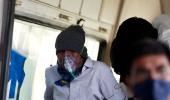Amid a rise in cases of the seasonal influenza subtype H3N2, the Centre on Saturday expressed concern over a gradual increase in the COVID-19 positivity rate in some states and said it needed to be promptly addressed.

The Centre requested all states and Union territories to follow operational guidelines for integrated surveillance of respiratory pathogens presenting as cases of influenza-like illness (ILI) or severe acute respiratory infection (SARI).
The states were also requested to take a stock of hospital preparedness such as availability of drugs and medical oxygen, vaccination coverage against COVID-19 and influenza.
"While the COVID-19 trajectory has decreased substantially in last few months, the gradual rise in COVID-19 test positivity rates in some states is a concerning issue that needs to be promptly addressed," Union Health Secretary Rajesh Bhushan said in a letter to states and UTs on Saturday.
Despite low number of new cases, equally low number of hospitalisations and significant advances made in terms of COVID-19 vaccination coverage, Bhushan said, there is a need to remain vigilant and focus on the five-fold strategy of test, track, treat, vaccination and adherence to Covid-appropriate behaviour.
In light of rising trend in other ILIs and SARIs being witnessed in some states and UTs across the country, a meeting was held recently to review the current situation with the central ministries, departments and organisations concerned.
While influenza is an annual seasonal occurrence, in the present season, a variety of weather conditions and behavioural reasons -- less than adequate attention to personal hygiene, coughing without adequate protection, closed indoor gatherings of people, etc. -- make the environment conducive to circulation of a number of viral respiratory pathogens like Influenza A (H1N1, H3N2 etc.) and adenoviruses, he mentioned.
Under the Integrated Disease Surveillance Programme, as reported by states and UTs, an increasing trend of ILI/SARI is being observed across the country, Bhushan stated.
Further, according to integrated sentinel based surveillance of ILI and SARI, an upswing of Influenza A is observed since the latter half of December last.
"Of particular concern is preponderance of Influenza A (H3N2) being detected in the samples being analysed in various labs. It should also be kept in mind that young children, old age people and people suffering from co-morbidites are particularly at risk and vulnerable to H1N1, H3N2, adenoviruses, etc," he said.
Additionally, since January 1, as per testing of respiratory samples being undertaken by various viral research and diagnostic labs (VRDLs), almost 25.4 per cent of the samples have tested positive for adenoviruses, he said.
While most of these agents typically cause a similar mild and often self-limiting illness manifesting acute respiratory infection with fever and cough, in some cases, particularly old age people, people with obesity and other co-morbidities as well as pregnant females, those infected may suffer from a more severe manifestation of these diseases requiring hospitalisation, Bhushan underlined.
"In order to limit transmission of these diseases, it is important to raise community awareness regarding adherence to respiratory and hand hygiene and promoting early reporting of symptoms, and limiting contact of those people who are suffering from respiratory illness," Bhushan wrote in the letter.
In terms of requisite public health actions, it is essential that state and district IDSP units closely follow the trend of ILI and SARI in their respective areas, monitor the proportion of cases and refer sufficient number of samples for testing for influenza, SARS-CoV-2 and adenovirus.
"All states and UTs must in letter and spirit implement 'Operational Guidelines for Revised Surveillance Strategy in Context of COVID-19' which provides for integrated surveillance of respiratory pathogens presenting as cases of ILI/SARI," the letter stated.










